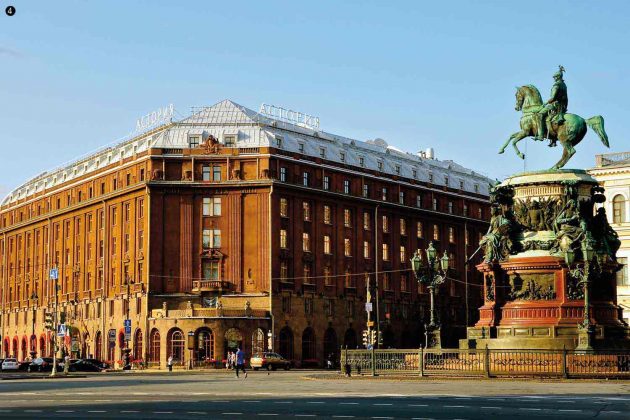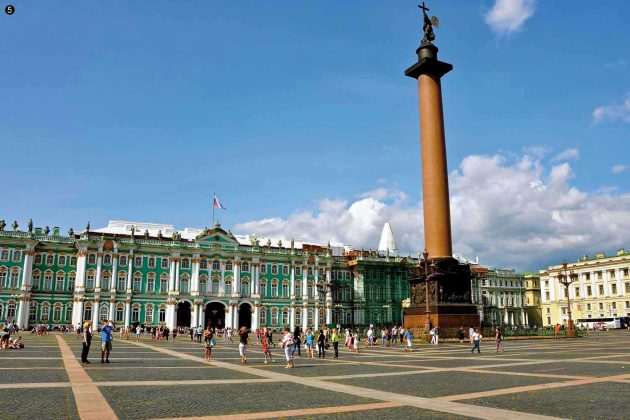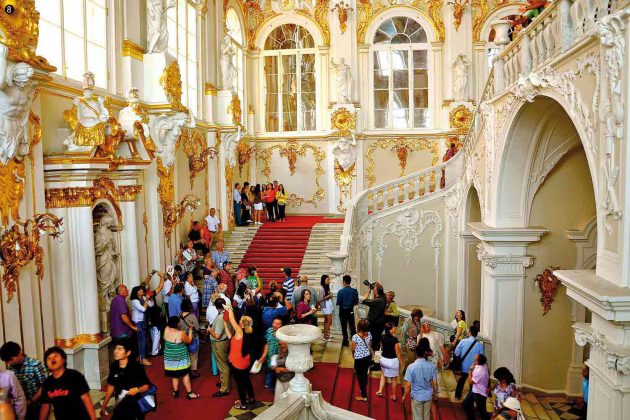Imagine the distress of a person who’s been tossing and turning for three nights in a row on probably one of the softest beds in one of the best hotels in St. Petersburg that too after exhausting days of sightseeing. No, there wasn’t a pea under the mattresses. It was the ‘white nights’—the most fascinating phenomenon I’d encountered. Due to St. Petersburg’s northerly geographical location—a few latitudes south of the Arctic Circle, during summer the sun does not descend enough for the sky to grow completely dark! As a result, although it was way past midnight, light beamed through my hotel window, framing that fantastic view of Saint Isaac’s Cathedral against a faded purple sky like a medieval oil painting.
Enjoying the midnight sun
Propped against my pillow, I could see tiny figures moving on top of the massive cathedral and occasionally bright flashes from their camera blinded my vision. Across the street, St. Isaac’s Square swelled with evening revellers huddled on benches, chatting and laughing; cars were zooming past and for just a few seconds I could hear their loud thumping music. Clinking of wine glasses floated from restaurants, teenagers were rollerblading on the streets spurring each other on and the birds were still singing on trees. These balmy summer nights that held the brightness and vigour of mornings seemed like nature’s reparation for grey sub-zero winters that sends this Russian city under wraps for seven months. Like all things transient, locals understand its worth and have been celebrating the sun’s prolonged patronage ever since Peter the Great founded this city in the early 18th century. How could I ever draw a curtain on all this? And I mean that literally.
Revelling in ancient opulence
I was coming to grips with St. Petersburg’s age old veneer of aristocracy and opulence—the sweeping squares, the wide-cobbled streets lined with pastel coloured mansions, pretty wrought iron bridges over innumerable canals, onion domed churches and giant bronze statues of great Russian figures. That’s when I noticed the only thing familiar—a pale yellow aura, so typical of all Baltic cities, that swathes St. Petersburg at all times, growing rich and golden as the day gains momentum.
And in this illuminating light, while walking on Nevsky Prospekt, the city’s main thoroughfare, I was compelled to stop time and again to process everything the revered musicians, playwrights and painters of Russia may have experienced and captured in their creations.
It’s magnificent, to say the least, specially the intersection of Nevsky and Griboyedov Canal around evening. Dom Knigi, the city’s largest and most famous bookshop from 1938, housed in the richly decorated Singer Building, is swarmed with customers. Café Singer’s tables by the arched windows overlooking the mighty Kazan Cathedral are permanently occupied with starry-eyed romantics. There’s a street theatre across the road and a jam session few metres away, both obscured by an animated crowd.
A juxtaposition of the old and new
Along the canal, a lady is smoothening the folds of her gown with a gloved hand while holding a red parasol in the other. A velvet-robed gentleman stands by her, offering passersby a chance to take pictures with Russian nobility in exchange of rubles. How seamlessly they fit the backdrop! On a bench by the water, I spot babushkas soaking the sun, eyes closed, faces upturned and their ice cream wielding grandchildren clinging to their skirts. Busboys from various restaurants around the area are prepping for dinner.
My 21st century soul was constantly playing catch up with such 18th century refinement, spread lavishly across vast expanses of land, the land that I couldn’t traverse an inch without stumbling on some piece of history.
Russia’s turbulent history
And not all, as I found out, was gilded as the city’s façade. Hotel Astoria, the historic mansion where I was lying awake, was reportedly the proposed venue for Hitler’s victory banquet. The Führer was so confident of Leningrad’s quick fall during the siege—a Nazi military operation lasting 900 days, with the ultimate aim of razing St. Petersburg to the ground—that he got invitations printed in advance.
It was history’s most deadly blockade. The Germans had cut off all supplies routed to the city and its suburbs; intense bombing took thousands of lives and destroyed countless historic landmarks. Lack of food, water and utilities caused unparalleled famine killing four times more civilians than the bombings of Hiroshima and Nagasaki.
Moving on
While researching St. Petersburg before my visit, I was struck by a black and white photograph of Nevsky Prospect, dating from the time of the siege. The road looked brutally raked, with potholes all over and the mansions lining it appeared dismal. Apparently, Dom Knigi, the state bookshop I’d just bought postcards from, had its windows shattered and storage rooms flooded when a bomb dropped on a neighbouring building. Knowing what the city had endured vis-à-vis what I see today made me both distraught and hopeful at the same time.
I found solace in St. Petersburg’s stoicism, in the fact that it hasn’t forgotten but moved on, meticulously rebuilt itself by spending millions. The Palace Square—the space where the tsarist troops fired on peaceful protestors in 1905—is now filled with hoards of cheerful camera-wielding tourists, whose pictures will tell a different story.
Inside the Winter Palace
The imposing Winter Palace of Russian tsars, once pillaged by the Red Army and damaged during the siege, stands fully restored at the head of the square. It houses the world-renowned Hermitage Museum, where I’m headed, even though I detest being cooped up inside four walls.
The Hermitage, however, proved worthy of every second spent there—both the extravagant Rastrelli-designed interiors and the hundreds of paintings. Oh the paintings! The works of Da Vinci, Picasso, Rembrandt, Van Gogh, Monet, Dali, Gauguin and Rubens adorn its countless walls. The art lover in me tasted heaven a million times in the five hours I spent there.
My lifelong fascination with Henri Matisse’s paintings was kindled in Room 344 on the 2nd floor, after viewing ‘The Red Room’. Even as I write this, every fibre in my body pines to go back and stand in front of the giant canvases of ‘Dance’ and ‘Music’ and admire Matisse’s fearless strokes and eye-popping colours.
Making the most of the whitenights
Outside the Winter Palace, a slick salesman thrust a brochure in my hands advertising ‘Regular English-guided boat tours’. The next hour was spent riding a ferry with 20 other people over the graceful Fontanka river flowing into Moika and then through the breathtaking Zimny canal into Neva. Peter and Paul Cathedral’s golden spire was piercing the sky like a needle. But our guide however was pointing to the dome of St. Isaac’s Cathedral on the opposite bank, suggesting we climb its 300 steps to enjoy panoramic city views.
I don’t know about the others, but I took his advice to heart. As I clicked pictures atop Russia’s largest cathedral way past midnight, my eyes gazed at the red and green rooftops of the mansions around. I wondered if someone was looking out her window right this moment, wide awake because she too was bewitched by enchantment of the ‘white nights’.
1] Pic: Licensed under [CC BY 2.0] from kishjar? [flickr]
2, 7] Pic: Licensed under [CC BY 2.0] from persona.natali [flickr]
3-6, 8] Pics: Subhashish Dasgupta
Good to know
When to visit
June/July is when sub-arctic St. Petersburg experiences white nights and the city plunges in round-the-clock revelry. Museums, churches, restaurants, bars are open till late. Gardens are verdant, canals come alive with boat trippers and there are fireworks, open-air concerts and theatres galore.
Accommodation
If money isn’t an issue, stay at the historic Hotel Astoria. The names of its famous boarders such as, Prince Charles, A B Vajpayee, George Bush, Tony Blair and Margaret Thatcher among others are embossed in metal plaques by the elevator.
Dining
Sadko, opposite Mariinsky Theatre has beautiful folksy interiors with bright Zhostovo floral paintings on a subdued arched ceiling. Sitting under dramatic Murano glass chandeliers, you can have the most sublime Chicken Kiev. The waiters here are very chirpy and attentive.
Getting Around
Though St. Petersburg has opulent subway stations that can moonlight as art galleries, the city’s imperial charm is best absorbed on foot. Wear comfortable shoes because being Russia, spaces are vast and sprawling.
Travel tip
Lovers of Russian literature, should consider knocking on the doors of Pushkin, Nabokov and Dostoevsky’s apartments to explore their personal spaces and visit squares and streets in the city that are right out of their novels.
This was first published in the May 2015 issue of Complete Wellbeing.








